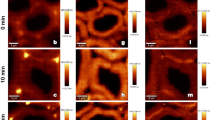Abstract
Biomass exhibits structural and chemical complexity over multiple size scales, presenting many challenges to the effective characterization of these materials. The macroscopic nature of plants requires that some form of size reduction, such as dissection and microtomy, be performed to prepare samples and reveal features of interest for any microscopic and nanoscopic analyses. These size reduction techniques, particularly sectioning and microtomy, are complicated by the inherent porosity of plant tissue that often necessitates fixation and embedding in a supporting matrix to preserve structural integrity. The chemical structure of plant cell walls is vastly different from that of the membrane bound organelles and protein macromolecular complexes within the cytosol, which are the focus of many traditional transmission electron microscopy (TEM) investigations in structural biology; thus, staining procedures developed for the latter are not optimized for biomass. While the moisture content of biomass is dramatically reduced compared to the living plant tissue, the residual water is still problematic for microscopic techniques conducted under vacuum such as scanning electron microscopy (SEM). This requires that samples must be carefully dehydrated or that the instrument must be operated in an environmental mode to accommodate the presence of water. In this chapter we highlight tools and techniques that have been successfully used to address these challenges and present procedural details regarding the preparation of biomass samples that enable effective and accurate multi-scale microscopic analysis.
Access this chapter
Tax calculation will be finalised at checkout
Purchases are for personal use only
Similar content being viewed by others
References
Zeng MJ, Mosier NS et al (2007) Microscopic examination of changes of plant cell structure in corn stover due to hot water pretreatment and enzymatic hydrolysis. Biotechnol Bioeng 97:265–278
Donohoe BS, Decker SR et al (2008) Visualizing lignin coalescence and migration through maize cell walls following thermochemical pretreatment. Biotechnol Bioeng 101:913–925
Donohoe BS, Selig MJ et al (2009) Detecting cellulase penetration into corn stover cell walls by immuno-electron microscopy. Biotechnol Bioeng 103:480–489
Singh S, Simmons BS et al (2009) Visualization of biomass solubilization and cellulose regeneration during ionic liquid pretreatment of switchgrass. Biotechnol Bioeng 104:68–75
Chundawat SPS, Donohoe BS et al (2011) Multi-scale visualization and characterization of lignocellulosic plant cell wall deconstruction during thermochemical pretreatment. Energy Environ Sci 4:973–984
McCann MC, Carpita NC (2008) Designing the deconstruction of plant cell walls. Curr Opin Plant Biol 11:314–320
Chebli Y, Daher F et al. (2008) Microwave assisted processing of plant cells for optical and electron microscopy. Bull Micro Soc 36(3):15–19
Humphrey E (2005) Microwave processing in a modern microscopy facility. Scanning 27:74–74
Kaneda M, Rensing KH et al (2008) Tracking monolignols during wood development in lodgepole pine. Plant Physiol 147:1750–1760
Giddings TH (2003) Freeze-substitution protocols for improved visualization of membranes in high-pressure frozen samples. J Microsc Oxf 212:53–61
Hess MW (2007) Cryopreparation methodology for plant cell biology. Cell Electron Microsc 79:57–100
Kang BH (2010) Electron microscopy and high-pressure freezing of Arabidopsis. Electron Microsc Model Syst 96:259–283
McDonald K, Morphew MK (1993) Improved preservation of ultrastructure in difficult-to-fix organisms by high-pressure freezing and freeze substitution 1. Drosophila melanogaster and Stronglyocentrotus purpuratus Embryos. Microsc Res Techn 24:465–473
Echlin P (1978) Coating techniques for scanning electron microscopy and X-ray microanalysis. Scanning Electron Microscopy I, 109–132
Echlin P (1981) Recent advances in specimen coating techniques. Scanning Electron Microsc I:79–90
Ladinsky MS, Pierson JM et al (2006) Vitreous cryo-sectioning of cells facilitated by a micromanipulator. J Microsc Oxf 224:129–134
Gilkey JC, Staehelin LA (1986) Advances in ultra-rapid freezing for the preservation of cellular ultrastructure. J Electron Microsc Tech 3:177–210
Acknowledgements
This work was supported by the US Department of Energy Office of the Biomass Program (BSD and TBV) and the Center for direct Catalytic Conversion of Biomass to Biofuels (C3Bio), an Energy Frontier Research Center funded by the DOE, Office of Science, Office of Basic Energy Sciences under Award Number DE-SC0000997 (BSD and PNC). NREL is a national laboratory of the US Department of Energy, Office of Energy Efficiency and Renewable Energy, operated by the Alliance for Sustainable Energy, LLC.
Author information
Authors and Affiliations
Corresponding author
Editor information
Editors and Affiliations
Rights and permissions
Copyright information
© 2012 Springer Science+Business Media, LLC
About this protocol
Cite this protocol
Donohoe, B.S., Ciesielski, P.N., Vinzant, T.B. (2012). Preservation and Preparation of Lignocellulosic Biomass Samples for Multi-scale Microscopy Analysis. In: Himmel, M. (eds) Biomass Conversion. Methods in Molecular Biology, vol 908. Humana Press, Totowa, NJ. https://doi.org/10.1007/978-1-61779-956-3_4
Download citation
DOI: https://doi.org/10.1007/978-1-61779-956-3_4
Published:
Publisher Name: Humana Press, Totowa, NJ
Print ISBN: 978-1-61779-955-6
Online ISBN: 978-1-61779-956-3
eBook Packages: Springer Protocols




